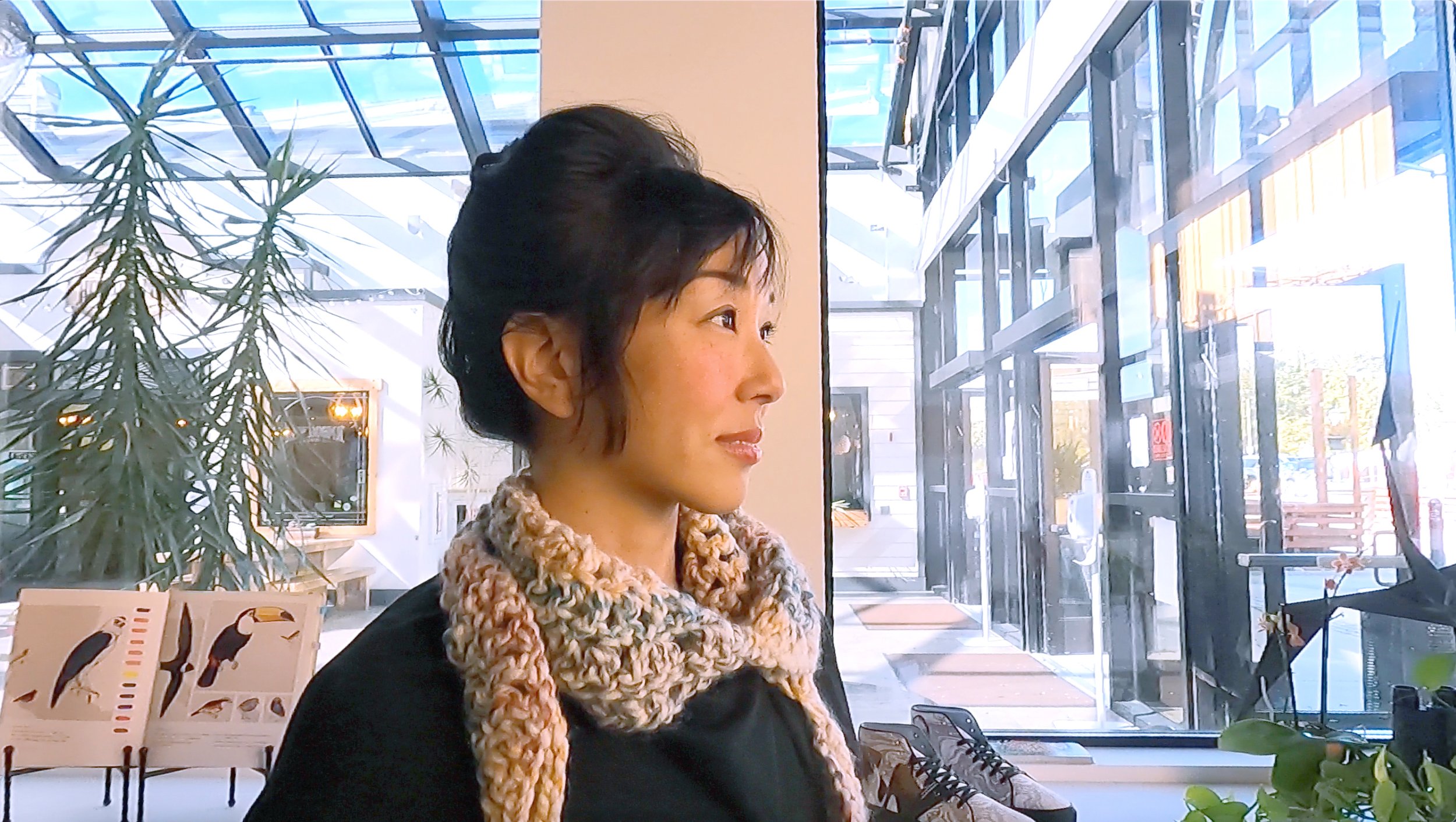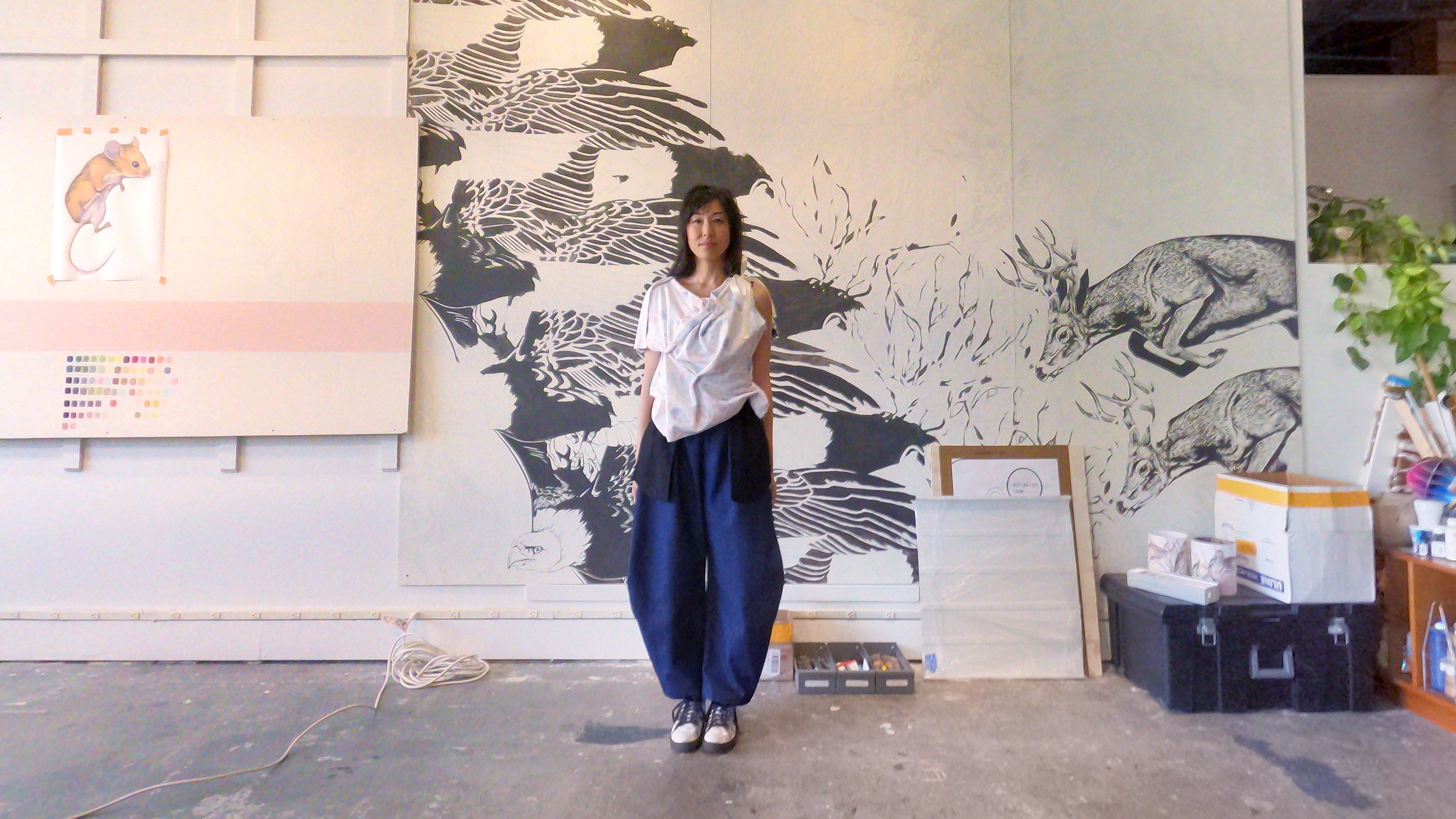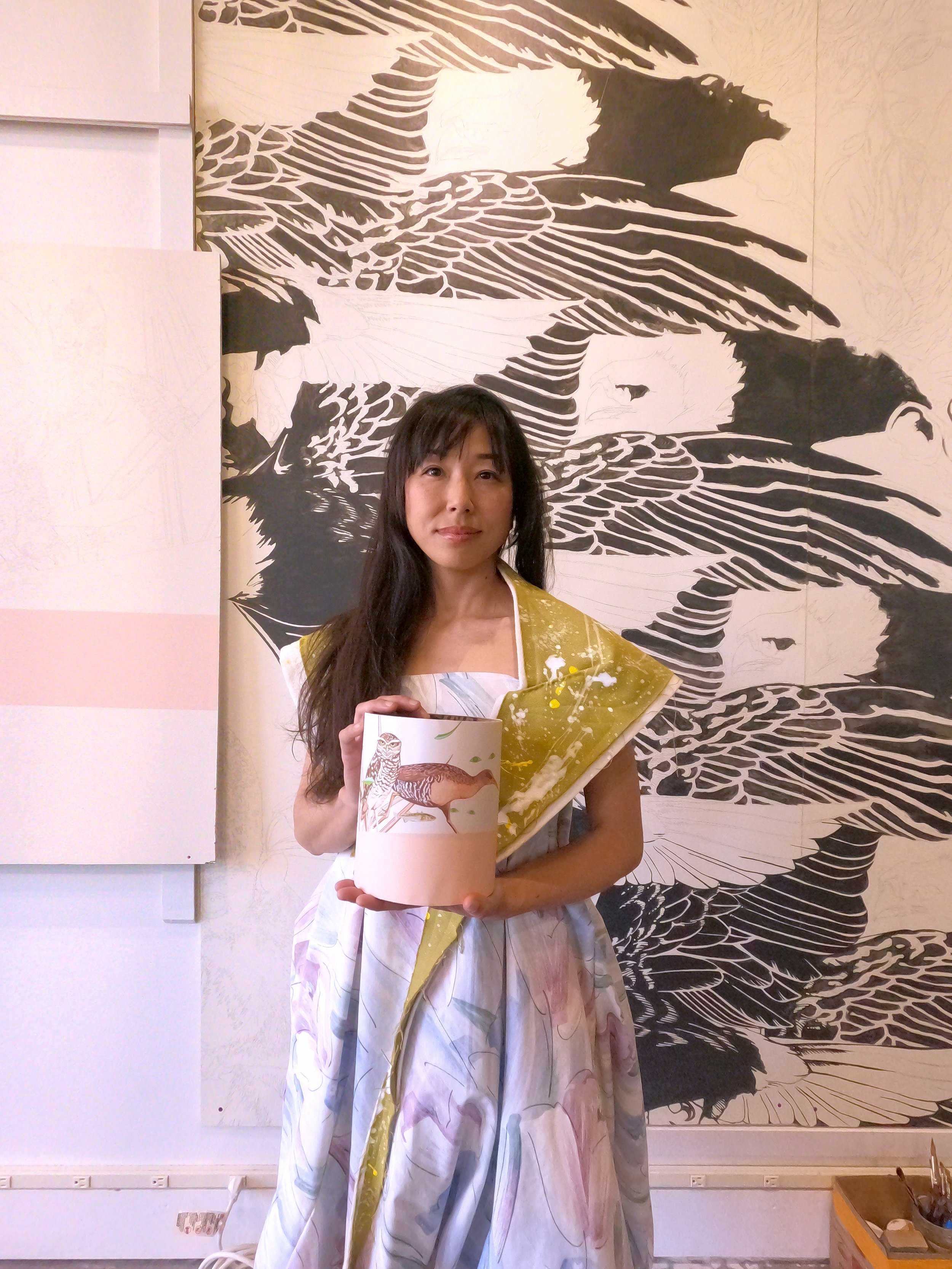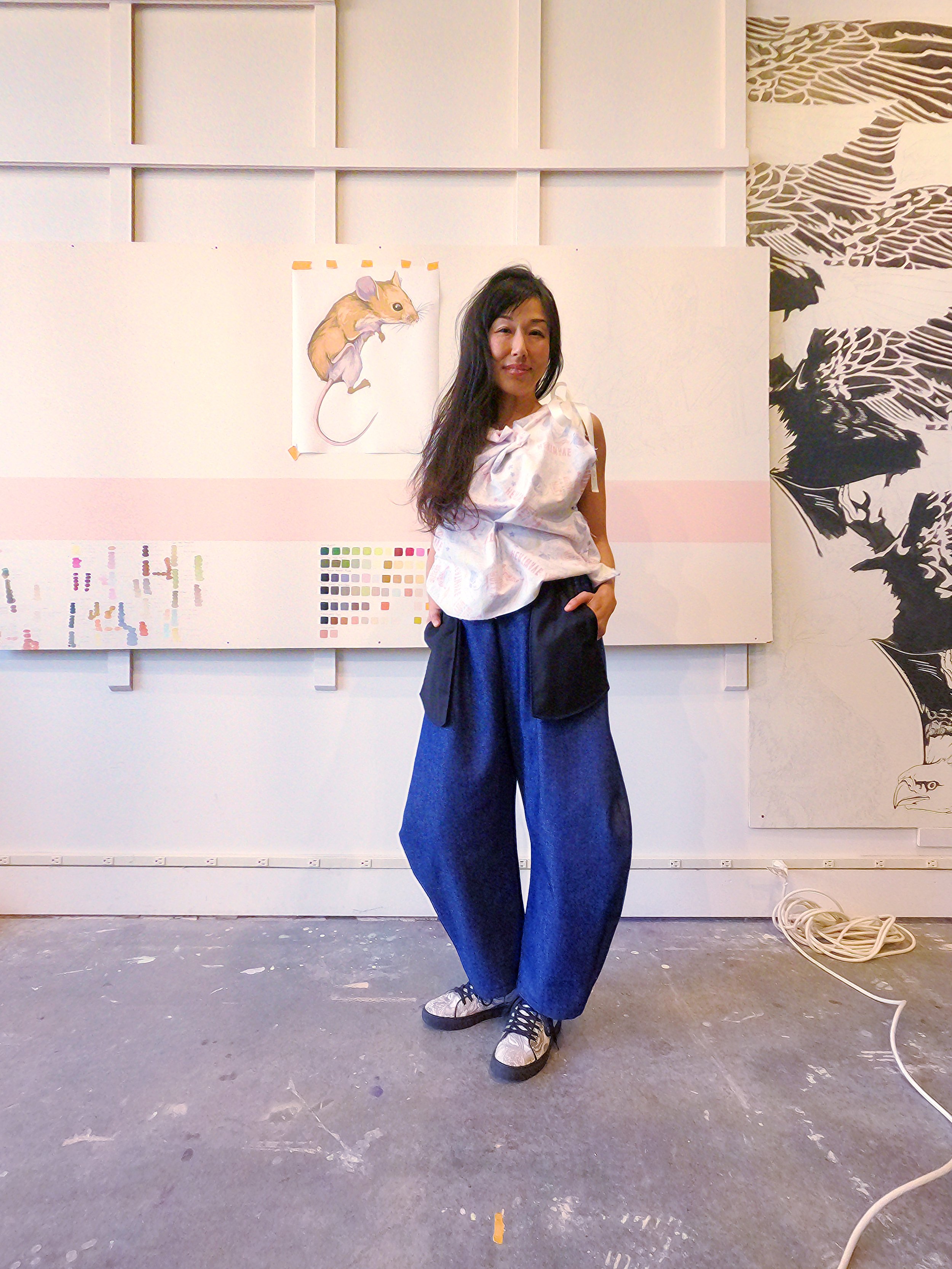Jane Kim of Ink Dwell
Photographs by Akiko Tsuji
Tucked away near the harbor of Half Moon Bay, I enter Jane Kim’s studio through an inconspicuous glass door, and I find myself in a room that appears like a space out of a natural history museum. Plants are visible throughout the space and an exposed high ceiling meets a partially painted white mural wall. I see color swatches next to an oversized painting of a mouse, and a large printout of a section of a beautiful Monarch butterfly, while large and small tools are placed neatly throughout. Then there is a taxidermied bear gently gazing toward the entrance. I spot spreads from the monthly science publication magazine that features Jane’s illustrations of local animals which include mammals, sea creatures, birds, plants, and insects.
Jane wears the Crocheted Circle scarf and the Billow dress.
Jane Kim is a visual artist, science illustrator, and the founder of Ink Dwell Studio working closely with her business partner and husband, Thayer Walker. Ink Dwell “creates art that explores the beauty and complexity of nature” and their most notable, and powerful works are murals such as the Wall of Birds at The Cornell Lab of Ornithology. A project in which every single bird is painted life-size, which took her team about 17 months from its conception to finish. In addition, the studio has produced works for the National Aquarium, the de Young Museum, Leigh Yawkey Woodson Art Museum, and more.
Another notable work of Ink Dwell is the Migrating Mural campaign, a series of public installations highlighting wildlife along human-inhabited migration corridors. Seeing the reproduction of animals painted on the walls of the structures along the highways and overpasses is soothing and brings out curiosity. As they are scientifically accurate, they cast an aura that is serious and informative without any verbal messaging.
With Cliff the bear. Jane wears the Tulip M dress and the All-over shrug.
The amount of care Jane puts into painting - the precision of colors and details - brings life to these animals. As I capture her in these outfits, the artist moves around the studio talking about her work with the same warm, insightful, and welcoming spirit. As she shows me an illustration of a spiny lobster I realize how little I know about the plethora of wildlife that exists so close to me here in the Bay Area!
Akiko: Where does the name Ink Dwell derive from?
Jane: When I was a student at CSUMB in Science Illustration, I started a blog called Ink-Dwell. Yes, there used to be a hyphen between the two words. It was a play on words—work that is “Inked Well” and depicts places I like to Dwell, nature. This name carried over.
Jane in the Reverse top and the custom Balcony denim pants.
A: You have acquired a master’s certificate in science illustration, were you always interested in the field of science, animals, and biology? Which came first, art or science?
J: My love of art and nature has defined me my whole life. The way I integrate biology and science developed over time.
A: Do the current or ongoing concerns of diminishing local species such as the Monarch butterflies drive you to be more active in the field of habitat conservation? If so, what are the things you are involved in?
J: Absolutely. Our work is our activation and contribution to habitat conservation. First and foremost, Ink Dwell’s work starts with driving awareness. In addition, many of our projects drive restoration efforts. In the case of the Monarch butterfly, the majority of our Migrating Murals resulted in our partners planting and restoring the surrounding landscape with native nectar-producing plants. Weber State University planted two acres of native milkweed as a result of our collaboration!
A: How easy or difficult is it to invite or encourage the Monarch butterflies back to a new or old habitat?
J: I like to say, if you plant it, they will come. And if not monarchs, planting native nectar plants will absolutely attract pollinators of all kinds and that impact is hugely important.
A: What effects do you hope to achieve through your mural works? What are some obstacles? Frustrations?
J: I hope to create collective consciousness around our surrounding environment. There are truly those who do not care about nature or even actively dislike it. How to make nature appealing or interesting to this group is one of my biggest challenges and frustrations.
Jane in the Billow dress and the All-over slip ons.
A: Which was your favorite project?
J: The Wall of Birds at the Cornell Lab of Ornithology. It is equal parts art, education, and science illustration and is also free to the public.
A: What mediums do you use and which are your favorites?
J: For murals and paintings, I use latex and acrylic paints. But I love to explore different mediums and sometimes rely on the narrative of the piece to drive what medium I use.
Jane holds a sand in glass piece wearing the Billow dress and the Crocheted Circle scarf.
A: Can you tell me about the sand in the glass piece?
J: As an artist-in-residence at San Francisco’s de Young Museum, I explored the concepts of ecology, sociology, and technology in the Bay Area by highlighting the relationship between native and non-native species in Golden Gate Park. In Golden Gate Park, this relationship has played out for more than a century. Originally a sand dune ecosystem, the park is entirely man-made. Today, through careful management, the park provides a home to a blend of native and non-native species. San Francisco’s original habitat was coastal scrub and sand dunes.
Today we stand on an artifact of human creation. Ocean Beach represents a tiny glimpse of San Francisco’s native habitat. Ocean Beach sand was collected and preserved inside the hand-blown glass. The glass started as a perfect sphere, representing a human’s ability to shape and control. The introduction of sand to the molten hot glass spheres creates organic and uncontrollable changes to the object’s overall form, representing nature.
A: What are your concerns, hopes, and mission for the future?
J: Oof. This is a big question. I have so many concerns! BUT….I also see the collective consciousness around the importance of sustainability and Earth care growing. This certainly gives me hope. Ultimately, I would love to see our country be humble enough to say that we made some serious mistakes in our system development and that we will be brave enough to develop new ones.
A: Can you tell me about your current and/or future projects?
Holding a scale model of the water tank that will be painted in Sunnyvale. Jane in the Tulip M dress and the All-over Shrug.
J: One future project that I am most looking forward to is with the town of Mariposa. In spring 2019, the Mariposa County Planning Department and Mariposa County Arts Council were jointly awarded support from the National Endowment for the Arts’ Our Town program to develop a countywide Creative Placemaking Strategy. This effort was recommended in several community planning and direction-setting initiatives, especially the Mariposa County General Plan (2006), including the Economic Development, Arts and Culture, and Regional Tourism Elements, each of which contains goals, policies, and programs that weave together economic development objectives with efforts to enhance and celebrate Mariposa County’s cultural identity and sense of place.
In addition to the General Plan, the Mariposa County Economic Vitality Strategy (2017) also recommends the development of a coordinated and strategic approach to conceptualizing, investing in, and managing creative placemaking projects in the county. We will be painting two murals this fall and collaborated with Atlas Lab in Sacramento to design welcome gates on either end of town. Currently, we are preparing to begin painting a mural on a massive water tank in the city of Sunnyvale honoring the Bayland ecosystem.
Jane in the Tulip M dress, the All-over shrug and the All-over slip-ons.
A: Some fun questions. What’s your favorite activity?
J: Karaoke!
A: Favorite books?
J: “The Fourth Turning: What the Cycles of History Tell Us About America’s Next Rendezvous with Destiny” I can’t recommend this book enough. I am reading it for a second time. I believe that it should be part of every high school AND college curriculum.
A: Favorite food or drink?
J: Gin martinis with a lemon.
Jane in the Reverse top and the custom Balcony denim pants. Shoes: artist’s own.
Details clockwise from top: Great blue herons, Black-tailed deer, Eastern grey tree squirrels, and Grey fox. Photos: Ink Dwell
One Monarch mural in San Francisco. Photo: Ink Dwell
To find out more visit Ink Dwell.













